trunk TOYOTA MIRAI 2022 Owner's Manual
[x] Cancel search | Manufacturer: TOYOTA, Model Year: 2022, Model line: MIRAI, Model: TOYOTA MIRAI 2022Pages: 556, PDF Size: 17.34 MB
Page 129 of 556
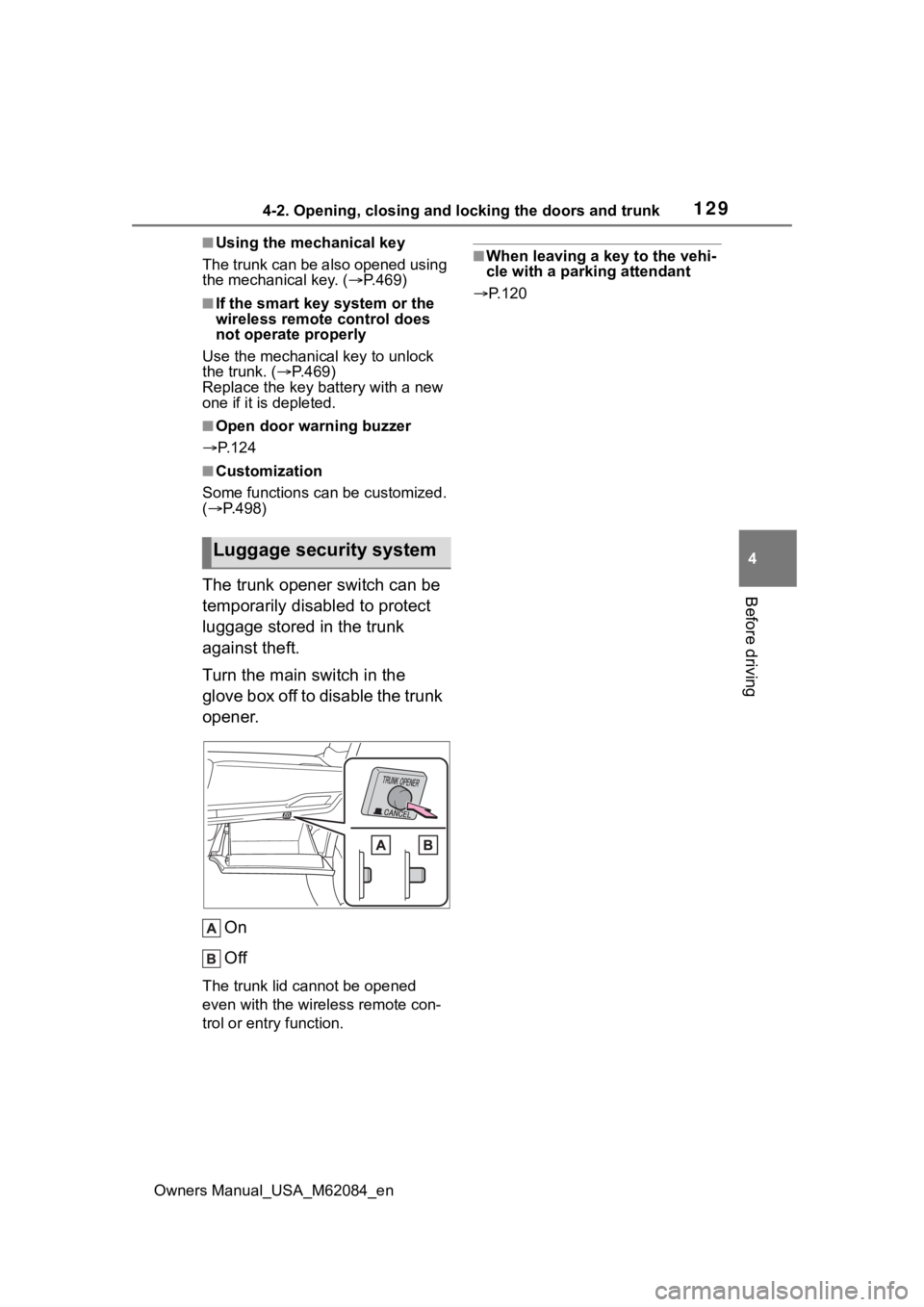
1294-2. Opening, closing and locking the doors and trunk
Owners Manual_USA_M62084_en
4
Before driving
Ō¢ĀUsing the mechanical key
The trunk can be also opened using
the mechanical key. ( ’é«P.469)
Ō¢ĀIf the smart key system or the
wireless remote control does
not operate properly
Use the mechanical key to unlock
the trunk. (’é« P.469)
Replace the key battery with a new
one if it is depleted.
Ō¢ĀOpen door warning buzzer
’é« P. 1 2 4
Ō¢ĀCustomization
Some functions can be customized.
( ’é« P.498)
The trunk opener switch can be
temporarily disabled to protect
luggage stored in the trunk
against theft.
Turn the main switch in the
glove box off to disable the trunk
opener.
On
Off
The trunk lid cannot be opened
even with the wireless remote con-
trol or entry function.
Ō¢ĀWhen leaving a key to the vehi-
cle with a parking attendant
’é« P.120
Luggage security system
Page 130 of 556
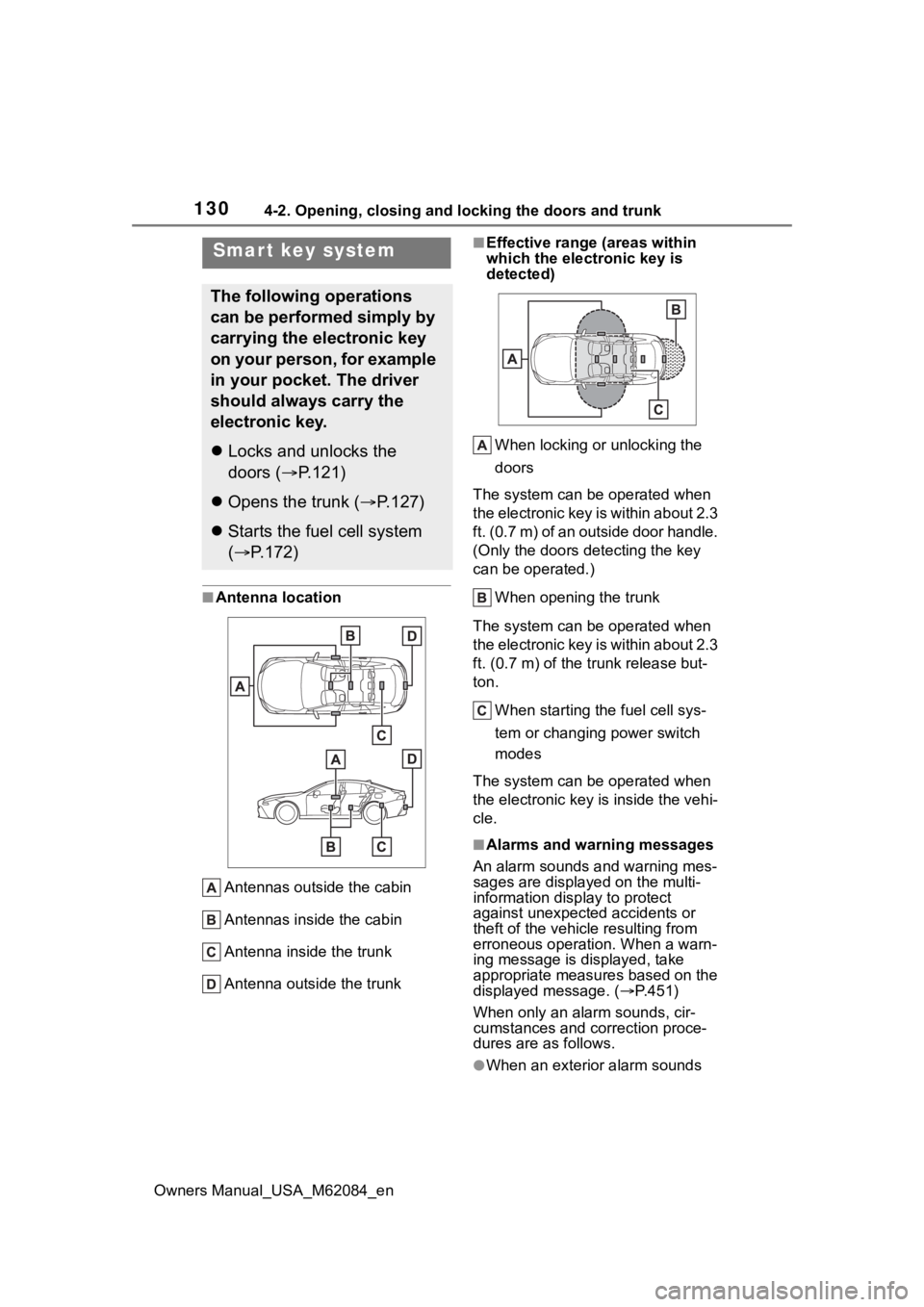
1304-2. Opening, closing and locking the doors and trunk
Owners Manual_USA_M62084_en
Ō¢ĀAntenna location
Antennas outside the cabin
Antennas inside the cabin
Antenna inside the trunk
Antenna outside the trunk
Ō¢ĀEffective range (areas within
which the electronic key is
detected)
When locking or unlocking the
doors
The system can be operated when
the electronic key is within about 2.3
ft. (0.7 m) of an outside door handle.
(Only the doors de tecting the key
can be operated.)
When opening the trunk
The system can be operated when
the electronic key is within about 2.3
ft. (0.7 m) of the trunk release but-
ton. When starting the fuel cell sys-
tem or changing power switch
modes
The system can be operated when
the electronic key i s inside the vehi-
cle.
Ō¢ĀAlarms and warning messages
An alarm sounds and warning mes-
sages are displayed on the multi-
information disp lay to protect
against unexpect ed accidents or
theft of the vehicle resulting from
erroneous operation. When a warn-
ing message is displayed, take
appropriate measures based on the
displayed message. ( ’é«P.451)
When only an alarm sounds, cir-
cumstances and correction proce-
dures are as follows.
ŌŚÅWhen an exterior alarm sounds
Smar t key system
The following operations
can be performed simply by
carrying the electronic key
on your person, for example
in your pocket. The driver
should always carry the
electronic key.
’ü¼ Locks and unlocks the
doors (’é« P.121)
’ü¼Opens the trunk (’é« P.127)
’ü¼Starts the fuel cell system
(’é« P.172)
Page 131 of 556
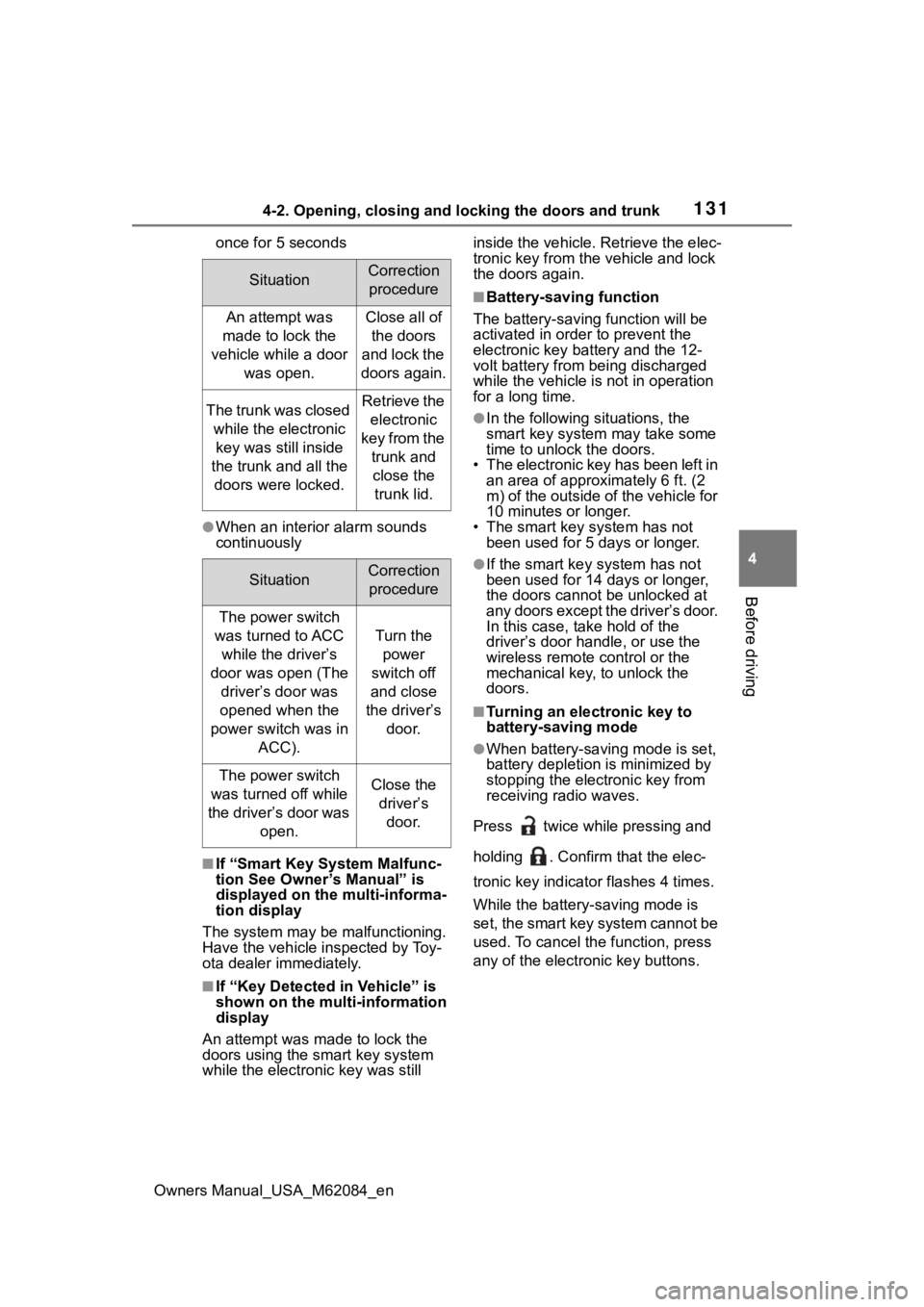
1314-2. Opening, closing and locking the doors and trunk
Owners Manual_USA_M62084_en
4
Before driving
once for 5 seconds
ŌŚÅWhen an interior alarm sounds
continuously
Ō¢ĀIf ŌĆ£Smart Key System Malfunc-
tion See OwnerŌĆÖs ManualŌĆØ is
displayed on the multi-informa-
tion display
The system may be malfunctioning.
Have the vehicle inspected by Toy-
ota dealer immediately.
Ō¢ĀIf ŌĆ£Key Detected in VehicleŌĆØ is
shown on the multi-information
display
An attempt was m ade to lock the
doors using the smart key system
while the electronic key was still inside the vehicle. Retrieve the elec-
tronic key from the vehicle and lock
the doors again.
Ō¢ĀBattery-saving function
The battery-saving function will be
activated in ord er to prevent the
electronic key battery and the 12-
volt battery from being discharged
while the vehicle is not in operation
for a long time.
ŌŚÅIn the following situations, the
smart key system may take some
time to unlock the doors.
ŌĆó The electronic key has been left in
an area of approxi mately 6 ft. (2
m) of the outside of the vehicle for
10 minutes or longer.
ŌĆó The smart key system has not been used for 5 days or longer.
ŌŚÅIf the smart key system has not
been used for 14 days or longer,
the doors cannot be unlocked at
any doors except the driverŌĆÖs door.
In this case, take hold of the
driverŌĆÖs door handle, or use the
wireless remote c ontrol or the
mechanical key, to unlock the
doors.
Ō¢ĀTurning an electronic key to
battery-saving mode
ŌŚÅWhen battery-saving mode is set,
battery depletion is minimized by
stopping the electronic key from
receiving radio waves.
Press twice while pressing and
holding . Confirm that the elec-
tronic key indicator flashes 4 times.
While the battery-saving mode is
set, the smart key system cannot be
used. To cancel the function, press
any of the electronic key buttons.
SituationCorrection procedure
An attempt was
made to lock the
vehicle while a door was open.Close all of the doors
and lock the
doors again.
The trunk was closed while the electronic key was still inside
the trunk and all the doors were locked.Retrieve the electronic
key from the trunk and close the trunk lid.
SituationCorrection procedure
The power switch
was turned to ACC while the driverŌĆÖs
door was open (The driverŌĆÖs door was
opened when the
power switch was in ACC).
Turn the power
switch off
and close
the driverŌĆÖs door.
The power switch
was turned off while
the driverŌĆÖs door was open.Close the driverŌĆÖs door.
Page 132 of 556
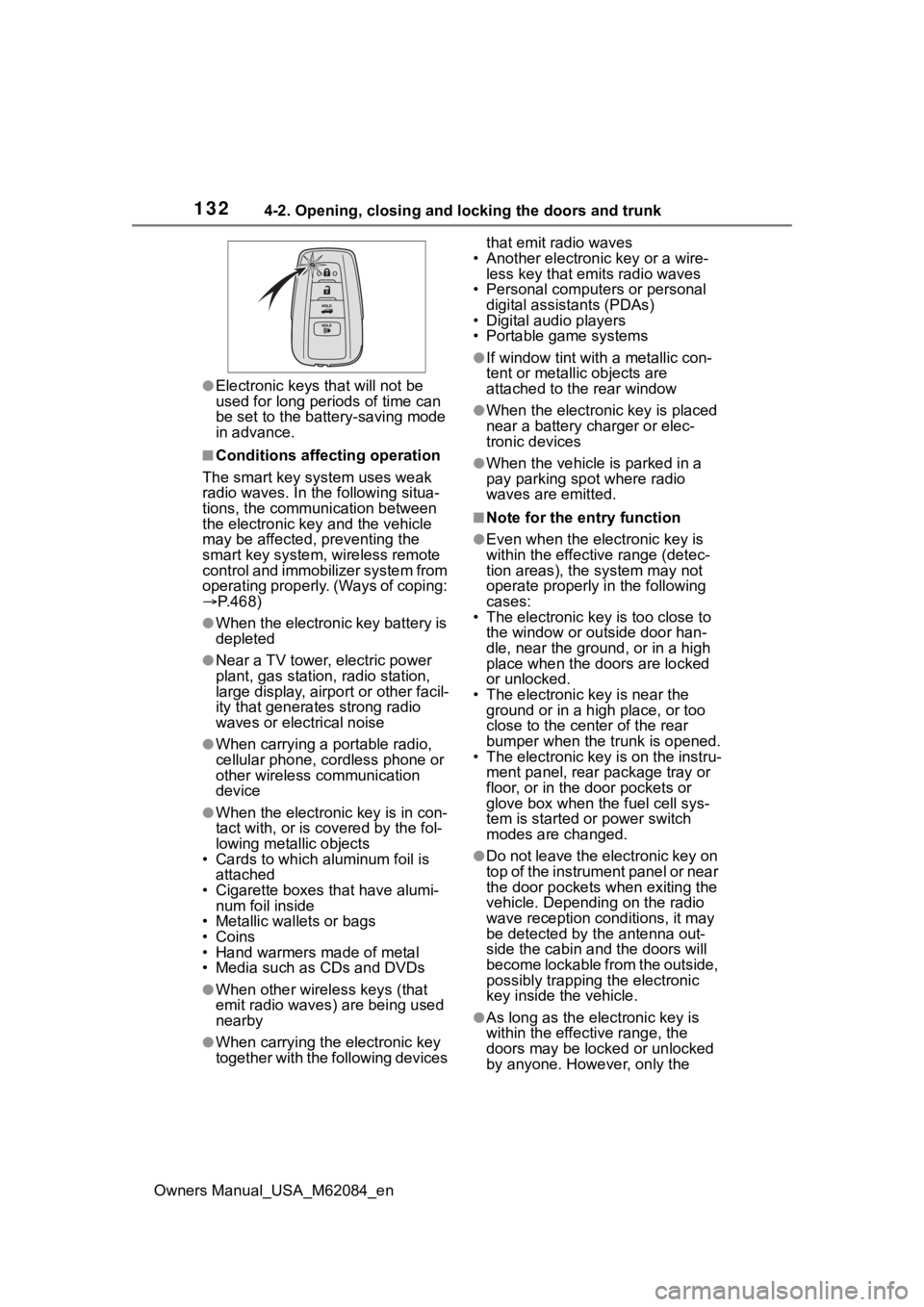
1324-2. Opening, closing and locking the doors and trunk
Owners Manual_USA_M62084_en
ŌŚÅElectronic keys that will not be
used for long periods of time can
be set to the battery-saving mode
in advance.
Ō¢ĀConditions affecting operation
The smart key system uses weak
radio waves. In the following situa-
tions, the communication between
the electronic key and the vehicle
may be affected, preventing the
smart key system, wireless remote
control and immobilizer system from
operating properly. (Ways of coping:
’é« P.468)
ŌŚÅWhen the electronic key battery is
depleted
ŌŚÅNear a TV tower, electric power
plant, gas station , radio station,
large display, airpo rt or other facil-
ity that generates strong radio
waves or electrical noise
ŌŚÅWhen carrying a portable radio,
cellular phone, cordless phone or
other wireless communication
device
ŌŚÅWhen the electronic key is in con-
tact with, or is covered by the fol-
lowing metallic objects
ŌĆó Cards to which al uminum foil is
attached
ŌĆó Cigarette boxes that have alumi- num foil inside
ŌĆó Metallic wallets or bags
ŌĆó Coins
ŌĆó Hand warmers made of metal
ŌĆó Media such as CDs and DVDs
ŌŚÅWhen other wireless keys (that
emit radio waves) are being used
nearby
ŌŚÅWhen carrying the electronic key
together with the following devices that emit radio waves
ŌĆó Another electronic key or a wire- less key that emits radio waves
ŌĆó Personal computers or personal digital assistants (PDAs)
ŌĆó Digital audio players
ŌĆó Portable game systems
ŌŚÅIf window tint wit h a metallic con-
tent or metallic objects are
attached to the rear window
ŌŚÅWhen the electronic key is placed
near a battery charger or elec-
tronic devices
ŌŚÅWhen the vehicle is parked in a
pay parking spot where radio
waves are emitted.
Ō¢ĀNote for the entry function
ŌŚÅEven when the electronic key is
within the effective range (detec-
tion areas), the system may not
operate properly in the following
cases:
ŌĆó The electronic key is too close to the window or outside door han-
dle, near the ground, or in a high
place when the doors are locked
or unlocked.
ŌĆó The electronic key is near the ground or in a high place, or too
close to the center of the rear
bumper when the trunk is opened.
ŌĆó The electronic key is on the instru- ment panel, rear package tray or
floor, or in the door pockets or
glove box when the fuel cell sys-
tem is started or power switch
modes are changed.
ŌŚÅDo not leave the electronic key on
top of the instrument panel or near
the door pockets when exiting the
vehicle. Depending on the radio
wave reception conditions, it may
be detected by the antenna out-
side the cabin and the doors will
become lockable from the outside,
possibly trapping the electronic
key inside the vehicle.
ŌŚÅAs long as the electronic key is
within the effective range, the
doors may be locked or unlocked
by anyone. However, only the
Page 133 of 556
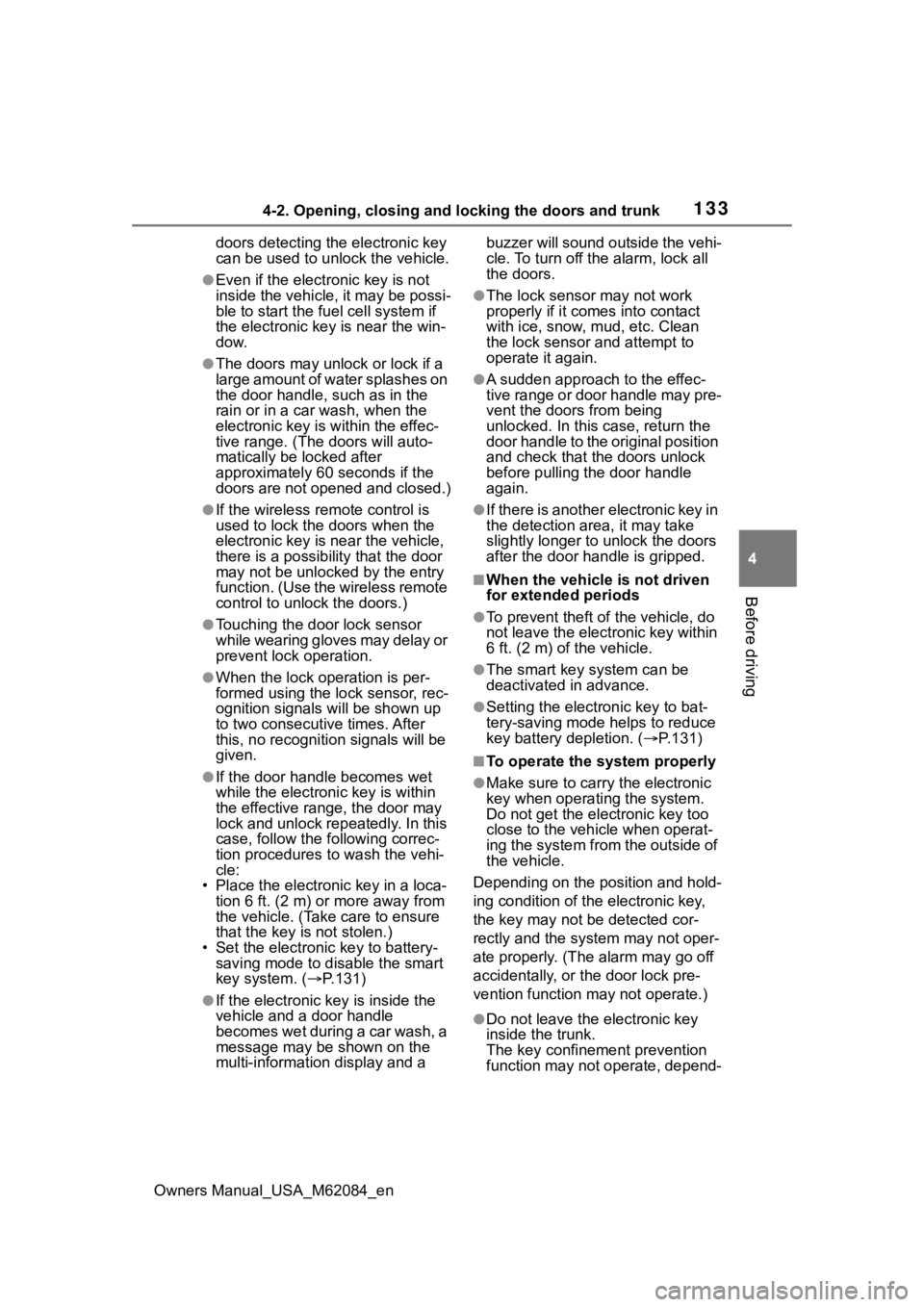
1334-2. Opening, closing and locking the doors and trunk
Owners Manual_USA_M62084_en
4
Before driving
doors detecting the electronic key
can be used to unl ock the vehicle.
ŌŚÅEven if the electronic key is not
inside the vehicle, it may be possi-
ble to start the fuel cell system if
the electronic key is near the win-
dow.
ŌŚÅThe doors may unlock or lock if a
large amount of water splashes on
the door handle, such as in the
rain or in a car wash, when the
electronic key is within the effec-
tive range. (The doors will auto-
matically be locked after
approximately 60 seconds if the
doors are not opened and closed.)
ŌŚÅIf the wireless remote control is
used to lock the doors when the
electronic key is near the vehicle,
there is a possib ility that the door
may not be unlocke d by the entry
function. (Use the wireless remote
control to unloc k the doors.)
ŌŚÅTouching the door lock sensor
while wearing gloves may delay or
prevent lock operation.
ŌŚÅWhen the lock op eration is per-
formed using the lock sensor, rec-
ognition signals will be shown up
to two consecutive times. After
this, no recogniti on signals will be
given.
ŌŚÅIf the door handle becomes wet
while the electronic key is within
the effective ran ge, the door may
lock and unlock repeatedly. In this
case, follow the fo llowing correc-
tion procedures to wash the vehi-
cle:
ŌĆó Place the electronic key in a loca- tion 6 ft. (2 m) or more away from
the vehicle. (Take care to ensure
that the key is not stolen.)
ŌĆó Set the electronic key to battery- saving mode to disable the smart
key system. ( ’é«P.131)
ŌŚÅIf the electronic key is inside the
vehicle and a door handle
becomes wet during a car wash, a
message may be shown on the
multi-informatio n display and a buzzer will sound outside the vehi-
cle. To turn off the alarm, lock all
the doors.
ŌŚÅThe lock sensor may not work
properly if it comes into contact
with ice, snow, m
ud, etc. Clean
the lock sensor and attempt to
operate it again.
ŌŚÅA sudden approach to the effec-
tive range or door handle may pre-
vent the doors from being
unlocked. In this case, return the
door handle to the original position
and check that t he doors unlock
before pulling the door handle
again.
ŌŚÅIf there is another electronic key in
the detection area, it may take
slightly longer to unlock the doors
after the door handle is gripped.
Ō¢ĀWhen the vehicle is not driven
for extended periods
ŌŚÅTo prevent theft of the vehicle, do
not leave the electronic key within
6 ft. (2 m) of the vehicle.
ŌŚÅThe smart key system can be
deactivated in advance.
ŌŚÅSetting the electronic key to bat-
tery-saving mode helps to reduce
key battery depletion. ( ’é«P.131)
Ō¢ĀTo operate the system properly
ŌŚÅMake sure to carry the electronic
key when operating the system.
Do not get the electronic key too
close to the vehicle when operat-
ing the system from the outside of
the vehicle.
Depending on the position and hold-
ing condition of the electronic key,
the key may not be detected cor-
rectly and the system may not oper-
ate properly. (The alarm may go off
accidentally, or the door lock pre-
vention function m ay not operate.)
ŌŚÅDo not leave the electronic key
inside the trunk.
The key confinement prevention
function may not operate, depend-
Page 134 of 556
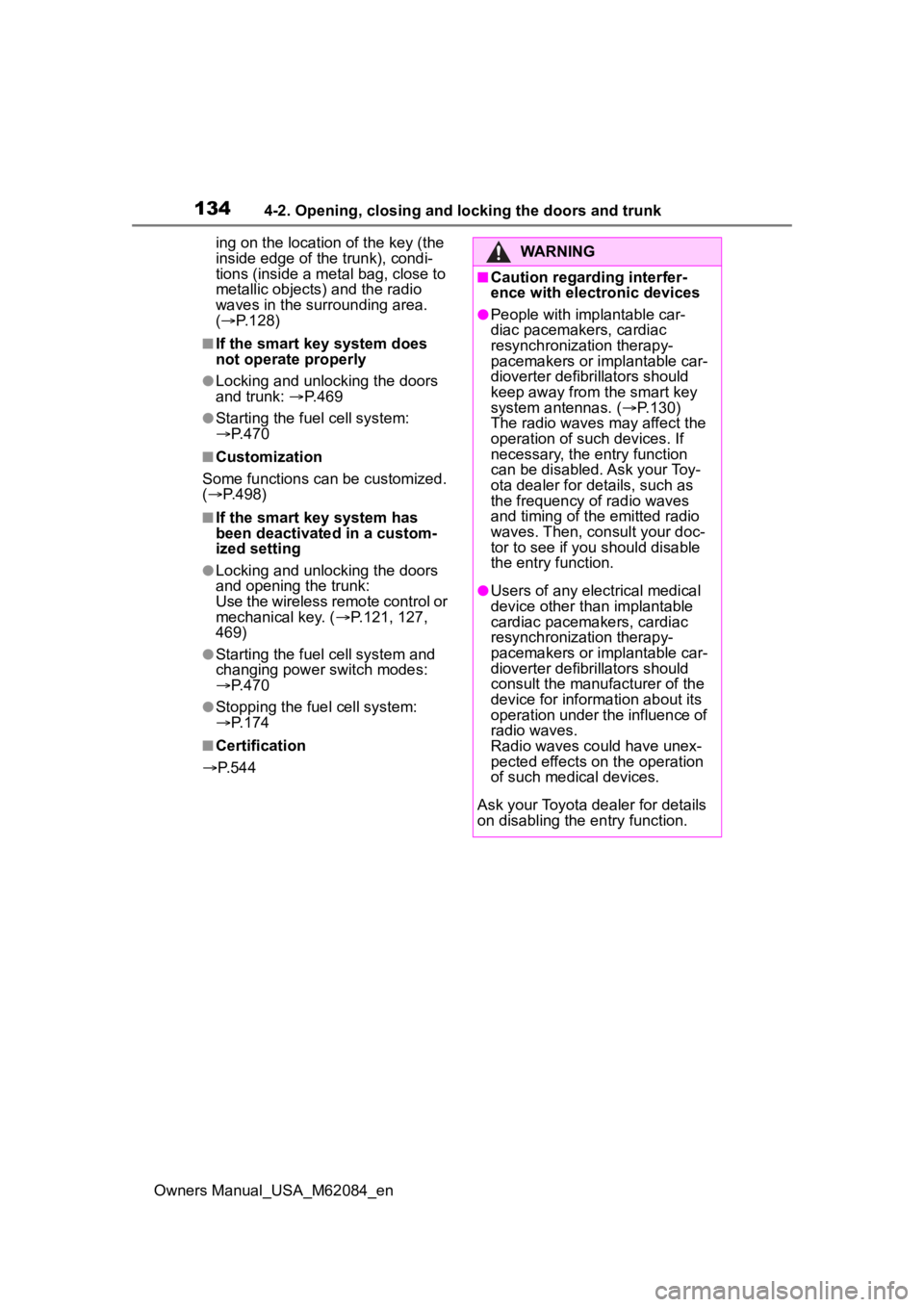
1344-2. Opening, closing and locking the doors and trunk
Owners Manual_USA_M62084_ening on the location of the key (the
inside edge of the
trunk), condi-
tions (inside a met al bag, close to
metallic objects) and the radio
waves in the surrounding area.
( ’é« P.128)
Ō¢ĀIf the smart key system does
not operate properly
ŌŚÅLocking and unlocking the doors
and trunk: ’é«P. 4 6 9
ŌŚÅStarting the fuel cell system:
’é«P. 4 7 0
Ō¢ĀCustomization
Some functions can be customized.
( ’é« P.498)
Ō¢ĀIf the smart key system has
been deactivated in a custom-
ized setting
ŌŚÅLocking and unlocking the doors
and opening the trunk:
Use the wireless remote control or
mechanical key. ( ’é«P.121, 127,
469)
ŌŚÅStarting the fuel cell system and
changing power switch modes:
’é« P. 4 7 0
ŌŚÅStopping the fuel cell system:
’é«P. 1 7 4
Ō¢ĀCertification
’é« P. 5 4 4
WARNING
Ō¢ĀCaution regarding interfer-
ence with electronic devices
ŌŚÅPeople with implantable car-
diac pacemakers, cardiac
resynchronization therapy-
pacemakers or implantable car-
dioverter defibrillators should
keep away from the smart key
system antennas. ( ’é«P.130)
The radio waves may affect the
operation of such devices. If
necessary, the entry function
can be disabled. Ask your Toy-
ota dealer for details, such as
the frequency of radio waves
and timing of the emitted radio
waves. Then, consult your doc-
tor to see if you should disable
the entry function.
ŌŚÅUsers of any electrical medical
device other than implantable
cardiac pacemakers, cardiac
resynchronization therapy-
pacemakers or implantable car-
dioverter defibrillators should
consult the manufacturer of the
device for information about its
operation under the influence of
radio waves.
Radio waves could have unex-
pected effects on the operation
of such medical devices.
Ask your Toyota dealer for details
on disabling the entry function.
Page 146 of 556
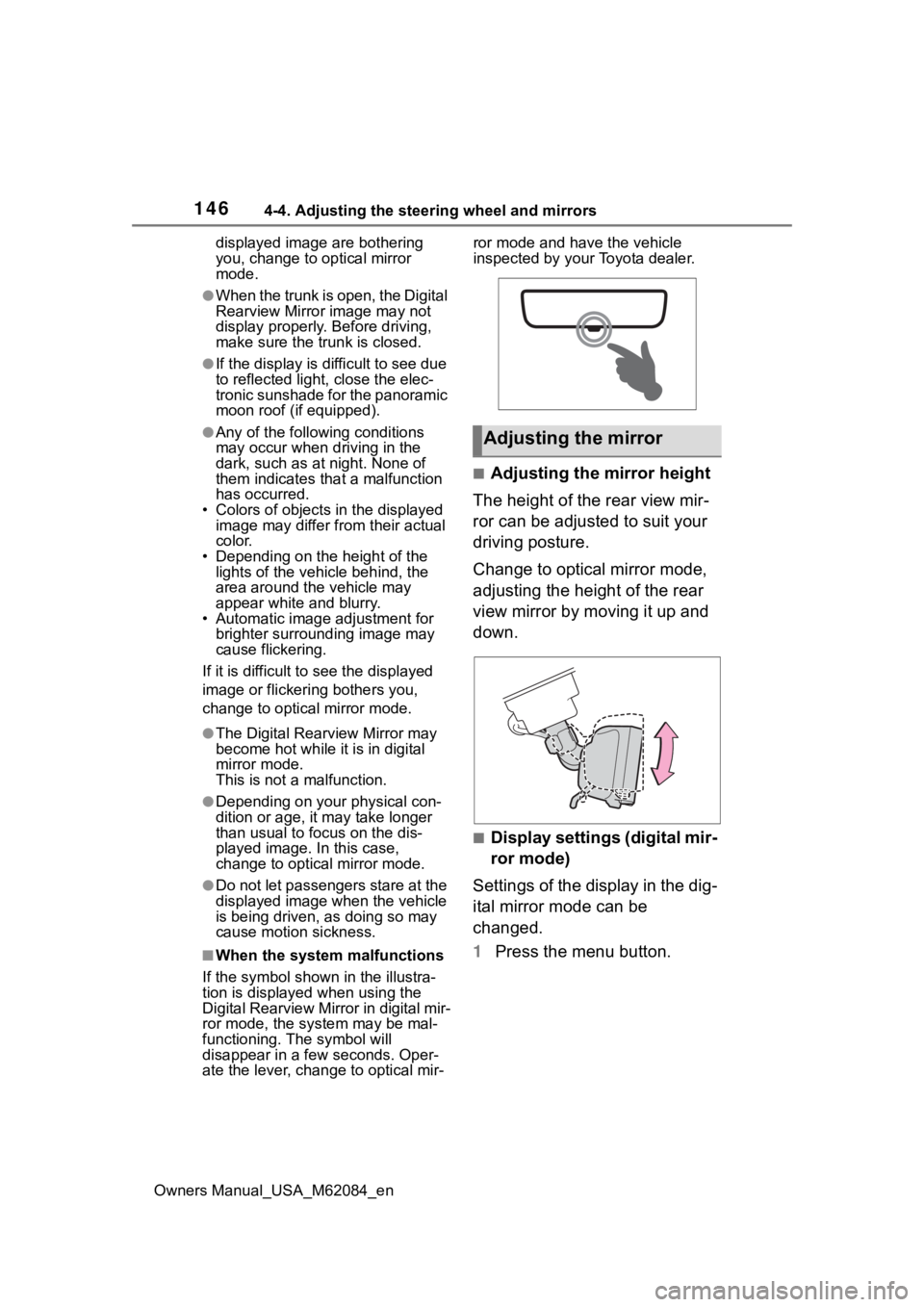
1464-4. Adjusting the steering wheel and mirrors
Owners Manual_USA_M62084_endisplayed image are bothering
you, change to optical mirror
mode.
ŌŚÅWhen the trunk is open, the Digital
Rearview Mirror image may not
display properly. Before driving,
make sure the trunk is closed.
ŌŚÅIf the display is difficult to see due
to reflected light, close the elec-
tronic sunshade for the panoramic
moon roof (if equipped).
ŌŚÅAny of the following conditions
may occur when d
riving in the
dark, such as at night. None of
them indicates that a malfunction
has occurred.
ŌĆó Colors of objects in the displayed image may differ f rom their actual
color.
ŌĆó Depending on the height of the lights of the vehicle behind, the
area around the vehicle may
appear white and blurry.
ŌĆó Automatic image adjustment for
brighter surrounding image may
cause flickering.
If it is difficult to see the displayed
image or flickering bothers you,
change to optical mirror mode.
ŌŚÅThe Digital Rearview Mirror may
become hot while it is in digital
mirror mode.
This is not a malfunction.
ŌŚÅDepending on your physical con-
dition or age, it may take longer
than usual to focus on the dis-
played image. In this case,
change to optical mirror mode.
ŌŚÅDo not let passengers stare at the
displayed image when the vehicle
is being driven, as doing so may
cause motion sickness.
Ō¢ĀWhen the system malfunctions
If the symbol show n in the illustra-
tion is displayed when using the
Digital Rearview Mirror in digital mir-
ror mode, the system may be mal-
functioning. The symbol will
disappear in a few seconds. Oper-
ate the lever, chang e to optical mir-ror mode and have the vehicle
inspected by your Toyota dealer.
Ō¢ĀAdjusting the mirror height
The height of the rear view mir-
ror can be adjusted to suit your
driving posture.
Change to optical mirror mode,
adjusting the height of the rear
view mirror by moving it up and
down.
Ō¢ĀDisplay settings (digital mir-
ror mode)
Settings of the display in the dig-
ital mirror mode can be
changed.
1 Press the menu button.
Adjusting the mirror
Page 152 of 556
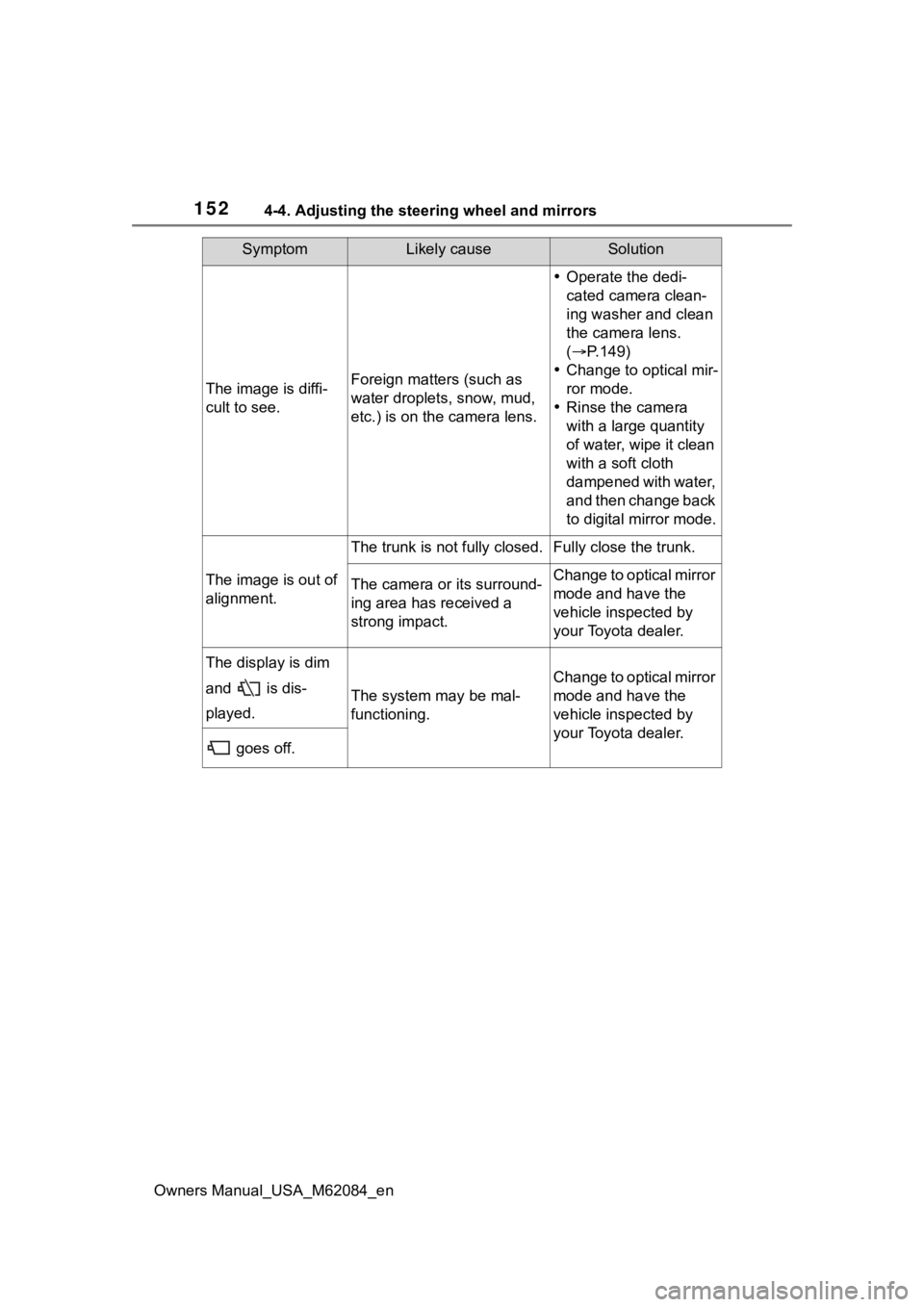
1524-4. Adjusting the steering wheel and mirrors
Owners Manual_USA_M62084_en
The image is diffi-
cult to see.Foreign matters (such as
water droplets, snow, mud,
etc.) is on the camera lens.
’éĘOperate the dedi-
cated camera clean-
ing washer and clean
the camera lens.
(’é« P.149)
’éĘ Change to optical mir-
ror mode.
’éĘ Rinse the camera
with a large quantity
of water, wipe it clean
with a soft cloth
dampened with water,
and then change back
to digital mirror mode.
The image is out of
alignment.
The trunk is not fully closed.Fully close the trunk.
The camera or its surround-
ing area has received a
strong impact.Change to optical mirror
mode and have the
vehicle inspected by
your Toyota dealer.
The display is dim
and is dis-
played.
The system may be mal-
functioning.
Change to optical mirror
mode and have the
vehicle inspected by
your Toyota dealer.
goes off.
SymptomLikely causeSolution
Page 169 of 556
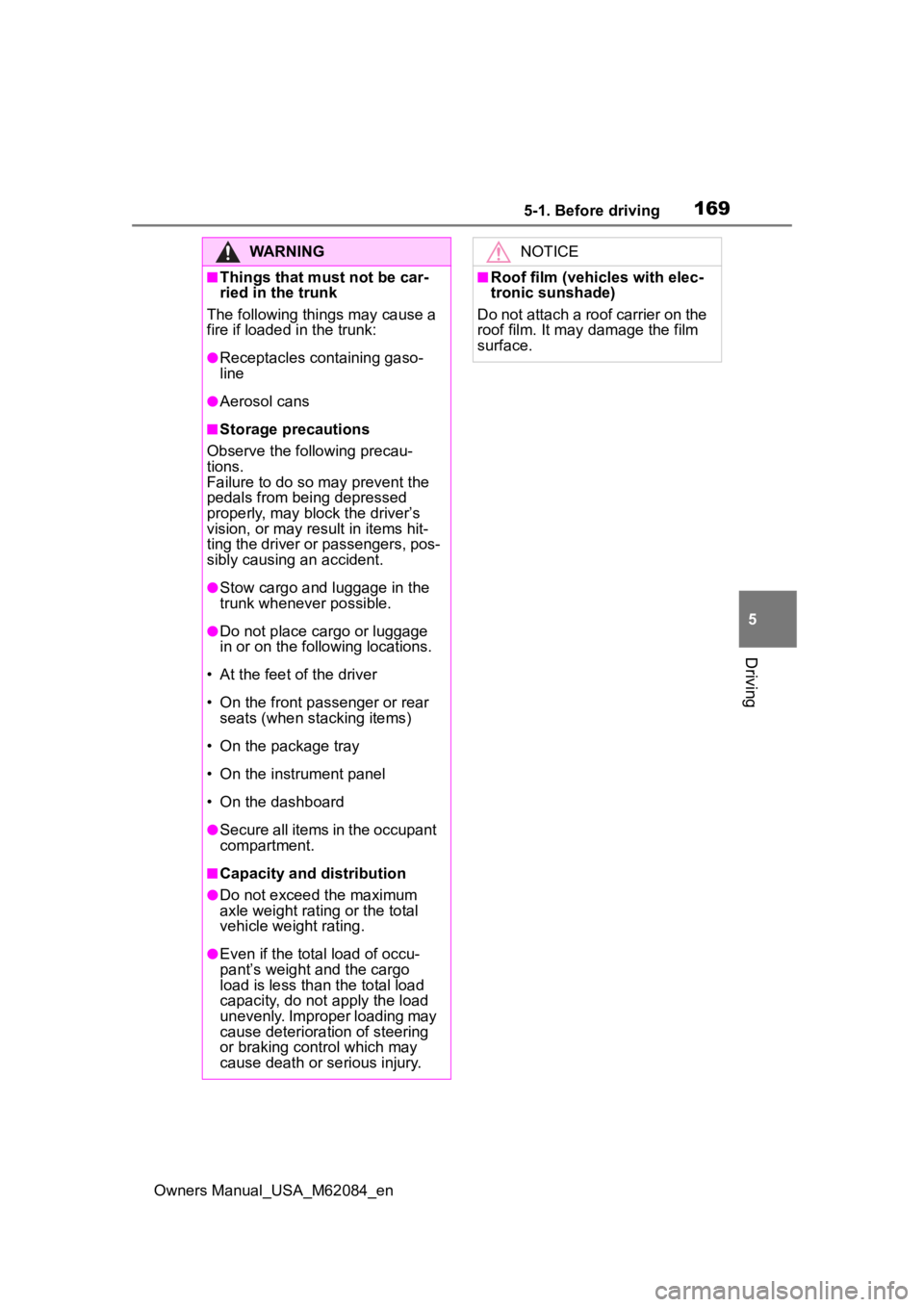
1695-1. Before driving
Owners Manual_USA_M62084_en
5
Driving
WARNING
Ō¢ĀThings that must not be car-
ried in the trunk
The following things may cause a
fire if loaded in the trunk:
ŌŚÅReceptacles co ntaining gaso-
line
ŌŚÅAerosol cans
Ō¢ĀStorage precautions
Observe the following precau-
tions.
Failure to do so m ay prevent the
pedals from being depressed
properly, may block the driverŌĆÖs
vision, or may result in items hit-
ting the driver or passengers, pos-
sibly causing an accident.
ŌŚÅStow cargo and luggage in the
trunk whenever possible.
ŌŚÅDo not place cargo or luggage
in or on the following locations.
ŌĆó At the feet of the driver
ŌĆó On the front passenger or rear seats (when stacking items)
ŌĆó On the package tray
ŌĆó On the instrument panel
ŌĆó On the dashboard
ŌŚÅSecure all items in the occupant
compartment.
Ō¢ĀCapacity and distribution
ŌŚÅDo not exceed the maximum
axle weight rating or the total
vehicle weight rating.
ŌŚÅEven if the tota l load of occu-
pantŌĆÖs weight and the cargo
load is less than the total load
capacity, do not apply the load
unevenly. Improper loading may
cause deteriorat ion of steering
or braking control which may
cause death or serious injury.
NOTICE
Ō¢ĀRoof film (vehicles with elec-
tronic sunshade)
Do not attach a roof carrier on the
roof film. It may damage the film
surface.
Page 192 of 556
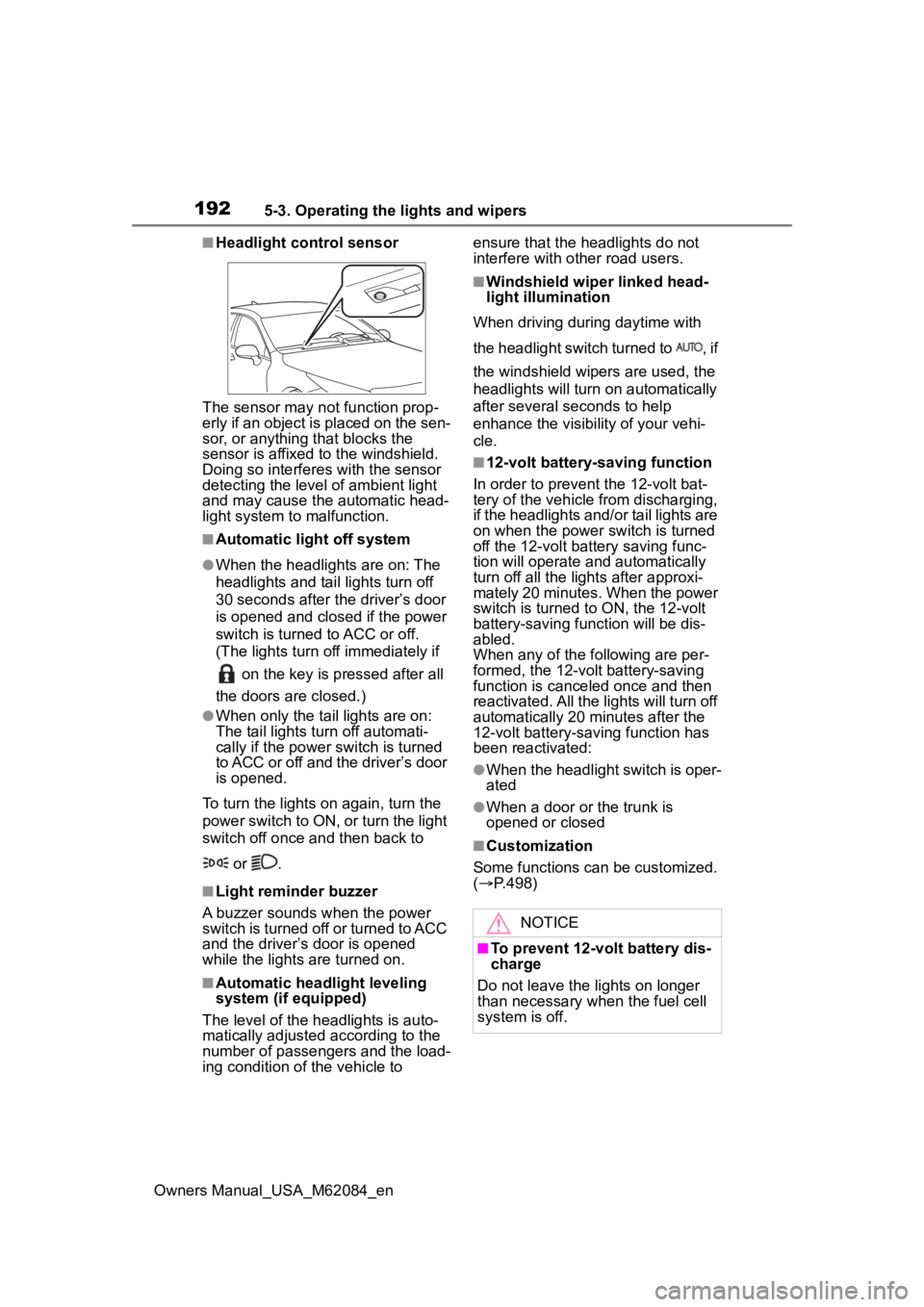
1925-3. Operating the lights and wipers
Owners Manual_USA_M62084_en
Ō¢ĀHeadlight control sensor
The sensor may not function prop-
erly if an object is placed on the sen-
sor, or anything that blocks the
sensor is affixed to the windshield.
Doing so interfere s with the sensor
detecting the level of ambient light
and may cause the automatic head-
light system to malfunction.
Ō¢ĀAutomatic light off system
ŌŚÅWhen the headlights are on: The
headlights and tail lights turn off
30 seconds after the driverŌĆÖs door
is opened and clos ed if the power
switch is turned to ACC or off.
(The lights turn off immediately if
on the key is pressed after all
the doors are closed.)
ŌŚÅWhen only the tail lights are on:
The tail lights tu rn off automati-
cally if the power switch is turned
to ACC or off and the driverŌĆÖs door
is opened.
To turn the lights on again, turn the
power switch to ON, or turn the light
switch off once and then back to
or .
Ō¢ĀLight reminder buzzer
A buzzer sounds when the power
switch is turned off or turned to ACC
and the driverŌĆÖs door is opened
while the lights are turned on.
Ō¢ĀAutomatic headlight leveling
system (if equipped)
The level of the headlights is auto-
matically adjusted according to the
number of passengers and the load-
ing condition of the vehicle to ensure that the headlights do not
interfere with other road users.
Ō¢ĀWindshield wiper linked head-
light illumination
When driving during daytime with
the headlight switch turned to , if
the windshield wipers are used, the
headlights will turn o n automatically
after several seconds to help
enhance the visibility of your vehi-
cle.
Ō¢Ā12-volt battery-saving function
In order to prevent the 12-volt bat-
tery of the vehicle from discharging,
if the headlights and/or tail lights are
on when the power switch is turned
off the 12-volt battery saving func-
tion will operate and automatically
turn off all the lig hts after approxi-
mately 20 minutes. When the power
switch is turned to ON, the 12-volt
battery-saving function will be dis-
abled.
When any of the following are per-
formed, the 12-volt battery-saving
function is canceled once and then
reactivated. All the lights will turn off
automatically 20 minutes after the
12-volt battery-saving function has
been reactivated:
ŌŚÅWhen the headlight switch is oper-
ated
ŌŚÅWhen a door or the trunk is
opened or closed
Ō¢ĀCustomization
Some functions can be customized.
( ’é« P.498)
NOTICE
Ō¢ĀTo prevent 12-volt battery dis-
charge
Do not leave the lights on longer
than necessary when the fuel cell
system is off.